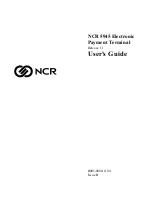
UP-5900VS
CIRCUIT DESCRIPTION
5 – 39
BUSY
66
Parallel Port
Input
Group 2
Busy – This pin is set high by the printer when it cannot accept another character. It is
internally connected to a weak pull-down resistor.
This signal is multiplexed with WAIT.
CFG0
92
Configuration
Input
Group 4
This pin selects between Full-IR and Two-UART mode as the default configuration
upon power up. It is pulled down by internal 30 K
Ω
resistors. External 10 KW pull-up
resistors to VDD should be employed.
This signal is multiplexed with SOUT1.
CLKIN
33
Clock
Input
Group 1
Clock In – A TTL or CMOS compatible 48 MHz clock.
CTS2,1
93,83
UART1,
UART2
Input
Group 1
UART1 and UART2 Clear to Send – When low, these signals indicate that the modem
or other data transfer device is ready to exchange data.
CTS2 is multiplexed with A11, and available only in Two-UART mode.
D7-0
8-1
ISA-Bus
I/O
Group 5
ISA-Bus Data – Bidirectional data lines to the microprocessor. D0 is the LSB and D7 is
the MSB. These signals have 24 mA (sink) buffered outputs.
DACK3
DACK2,1
42
39,38
ISA-Bus
Input
Group 1
DMA Acknowledge 1,2 and 3 – These active low input signals
acknowledge a request for DMA services and enable the IOWR and IORD input signals
during a DMA transfer. These DMA signals can be mapped to the following logical
devices: FDC, UART or Parallel Port.
DCD2,1
94,84
UART1,
UART2
Input
Group 1
UART1 and UART2 Data Carrier Detected – When low, this signal indicates that the
modem or other data transfer device has detected the data carrier.
DCD2 is multiplexed with P12 and available only in Two-UART mode.
DENSEL
97, 48 or 44
FDC
Output
Group 11
Density Select – Indicates that a high FDC density data rate (500 Kbps or 1 Mbps) or a
low density data rate (250 or 300 Kbps) is selected.
DENSEL polarity is controlled by bit 5 of the SuperI/O FDC Configuration register as
described in Section 2.5.1.
This signal is multiplexed with: IRTX, , DR1, or R12.
DIR
50
FDC
Output
Group 11
Direction – This output signal determines the direction of the Floppy Disk Drive (FDD)
head movement (active = step in, inactive = step out) during a seek operation. During
reads or writes, DIR is inactive.
DR1,0
48, 47
FDC
Output
Group 11
Drive Select 0 and 1 – These active low output signals are the decoded drive select
output signals. DR0 and DR1 are controlled by Digital Output Register (DOR) bits 0
and 1. They are encoded with information to control four FDDs when bit 7 of the
SuperI/O FDC Configuration register is 1, as described in Section 2.5.1.
DR0 can optionally become a logical OR of DR0 and MTR0 when MTR0/DRATE0 is
used as DRATE0.
DR1 is multiplexed with DENSEL and is available only in Two-UART mode. Optionally,
it can become a logical OR of DR1 and MTR1 when MTR1/P12 is used as P12.
DRATE0
95, 45 or 43
FDC
Output
Group 14
Data Rate 0 – This output signal reflects the value of bit 0 of the Configuration Control
Register (CCR) or the Data Rate Select Register (DSR), whichever was written to last.
Output from the pin is totem-pole buffered (6 mA sink, 6 mA source).
This signal is multiplexed with IRRX1/P12, MTR0 or DSR2
DRQ3-1
37-35
ISA-Bus
Output
Group 13
DMA Request 1, 2 and 3 – These active high output signals inform the DMA controller
that a data transfer is needed. These DMA signals can be mapped to the following log-
ical devices: Floppy Disk Controller (FDC), UART or parallel port.
DSKCHG
58
FDC
Input
Group 1
Disk Change – This input signal indicates whether or not the drive door has been
opened. The state of this pin is available from the Digital Input Register (DIR). This pin
can also be configured as the RGATE data separator diagnostic input signal via the
MODE command.
DSR2,1
95,85
UART1,
UART2
Input
Group 1
Data Set Ready – When low, this signal indicates that the data transfer device, e.g.,
modem, is ready to establish a communications link.
DSR2 is multiplexed with DRATE0 and available only in Two-UART mode.
DSTRB
74
Parallel Port
Output
Group 8
Data Strobe – This signal is used in EPP mode as a data strobe. It is active low.
DSTRB is multiplexed with AFD.
DTR2,1
96,86
UART1,
UART2
Output
Group 12
Data Terminal Ready – When low, this output signal indicates to the modem or other
data transfer device that the UART1 or UART2 is ready to establish a communications
link.
A Master Reset (MR) deactivates this signal high, and loopback operation holds this
signal inactive.
DTR1 is multiplexed with BADDR0 and with BOUT1.
DTR2 is multiplexed with IRSL2/ID2/BOUT2 and is available only in Two-UART mode.
(BOUT2 is multiplexed implicitly and controlled by UART2.)
ERR
71
Parallel Port
Input
Group 3
Error – This input signal is set active low by the printer when it has detected an error.
This pin is internally connected to an internal weak pull-up.
HDSEL
52
FDC
Output
Group 11
Head Select – This output signal determines which side of the FDD is accessed. Active
low selects side 1, inactive selects side 0.
Signal/Pin
Name
Pin Number
Module
I/O and
Group #
Function
















































